
| Palaeos: |  |
The Hadean Eon |
| Hadean | Introduction to the Hadean |
The name Hadean was coined by geologist Preston Cloud for the pre-Isuan sequence whose record may not be preserved on Earth but is better known from Moon rocks. Consequently, the time sequence and stratigraphy of the Hadean are largely based on lunar events. For example the Nectarian Era is defined by reference to the formation of the Nectaris Basin (southwestern Nearside). The Hadean has no place in the ICS system followed in the rest of Palaeos. The ICS lumps everything earlier than 3600 Mya into the Eoarchean Era of the Archean Eon. The Hadean, being an informal not stratigraphically defined eon, is here defined as the period from the Tellus (proto-Earth)-Theia impact (circa 4520 mya) to the end of the LHB (Late Heavy Bombardment) period, about 3800 bya. Recently, Goldblatt et al. 2010 have proposed an even earlier eon, the Chaotian, for events pertaining to the formation of the Solar System. Since the Chaotian pertains both to geology and astronomy, this allows us to posit an uninterrupted progression of cosmic evolution from pure cosmology through to pure geology, and continue the history of the Earth back to the early history of stars and galaxies, and ultimately the origin of the universe.
During Chaotian time, the Earth and Solar System formed by coagulation and gravitational contraction from a large cloud of gas and dust around the sun, called an accretion disc. The sun formed the nucleus, shrinking in on itself by gravitational compaction until it reached a stage where it ignited with nuclear fusion and give off light and heat. The surrounding particles within this cloud coalesced into planetesimals which then aggregated to form microplanets (rather like modern asteroids). The energy of the collisions between the larger microplanets, as well as interior radioactive and gravitational heating, generated a huge amount of heat, and the Earth and other planets would have been initially molten.
The Moon formed rather late in this process, about 45 My after the inner planets began to form. The current theory is that a Mars-sized planetoid, sometimes called Theia, collided with the Earth at this time. As astronomical collisions go, this was a mere cosmic fender-bender. The bodies, both molten, merged fairly smoothly, adding about 10% to Earth's mass. The moon formed from the minimal (about 0.01 Earth masses) orbiting debris resulting from this low-speed crash [3]. Apparently no one filed an insurance claim.
In the aftermath of collision, the heavier molten iron sank to the down to become the core of the Earth, while lighter elements gradually rose to the surface. The lightest of all became the crust as a sort of "scum" on the surface. There was also an outgassing of volatile molecules such as water, methane, ammonia, hydrogen, nitrogen, and carbon dioxide. An initial steam atmosphere formed of water from comets and hydrated minerals [4]. Rain fell to form a oceans 4.3 to 4.4 billion years ago.
Once most of the planetesimals were gone the planetary bombardment stopped, and a stable rocky crust formed on the Earth. This is the age of the oldest rocks on earth and also of moon rocks. Atmospheric water condensed into oceans and proto-life formed in the soup of primordial organic molecules, either in the early oceans or in clay or rocks within the crust itself. These stages are considered in more detail below. MAK & ATW, revised MAK110908
Since the Hadean lacks any official status, we have taken serious liberties in the process of updating this chronology. Originally, we started things off with the Cryptic, but this has now become the Titanomachean, the most recent period of the Chaotian eon. We have arbitrarily cut it off at the Theia Event, since this marks a real and rapid geological change from accretion to differentiation. (usefully, Goldblatt et al. 2010 use this same demarcation point). The "Basin Groups" don't seem to be used in serious geochronology at this point. Consequently, we have dropped them. This time period simply has no name. If it were up to us, we'd call it the Ryderian Era, in honor of Graham Ryder (1949-2002), whose short but amazing career in lunar geology laid much of the foundation for what we know about the Hadean. Following the new timescale of Goldblatt et al. 2010 however, this previously featureless expanse of time has now been divided into five new periods (shown above), although hopefully a Ryderian Era could still be included somewhere. For now, we have decided to follow the very provisional arrangement of Goldblatt et al. 2010, at least until something new comes along. This leaves the following:
| Eon | Era | Period | Epoch | when began
My ago |
duration
My |
Notes |
| Archean | Eoarchean | ~3800 - 3600 mya | Debatable geochemical evidence for life | |||
| Hadean | Neohadean | Promethean | Early Imbrian | 3,800-3,900 | 100-200 | Formation of Archean crust |
| Nectarian | 4,000 - 3,950 | 50 -100 | Resonance in Jupiter and Saturn's orbits moves Neptune out into the Kuiper belt. Late Heavy Bombardment occurs in the inner Solar System (c. 4100-3800 Ma) | |||
| Acastan | c. |
c. |
Max age of Acasta gneiss (oldest surviving continental fragment) | |||
| Mesohadean | Procrustean | c. |
c. |
(continued formation of continents) | ||
| Canadian | c. |
c. |
Max estimated age of earliest greenstone belt. | |||
| Palaeohadean | Jacobian | c. |
c. |
Earliest zircons (granite) | ||
| Hephaestean | c. |
c. |
Magma ocean, differentiation of core, mantle and "protocrust" | |||
| Chaotian (earlier) | Neochaotian | 4560 | ~60 | Accretion of terrestrial planets and Earth from solar disk; giant impacts, Theia Event; formation of Moon, Sun becomes a main sequence star. | ||
The Hadean or Pregeologic Eon is the time period during which the Earth was transformed from a gaseous cloud into a solid body. In terms of "Year of the Earth," it begins on January 1 and ends about 26 February. The process of solidification is poorly known, however, and the Hadean may have lasted as long as one billion years.
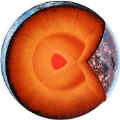 This is the period during which the
Earth's crust [1]was formed. This crust melted and reformed numerous times, because it was
continuously broken up by gigantic magma currents that erupted from the
depths of the planet, tore the thin crust, and then cooled off on the surface
before sinking again into the heart of the Earth.
This is the period during which the
Earth's crust [1]was formed. This crust melted and reformed numerous times, because it was
continuously broken up by gigantic magma currents that erupted from the
depths of the planet, tore the thin crust, and then cooled off on the surface
before sinking again into the heart of the Earth.
The details of this slow, destructive process are still uncertain. However, it is thought that the heavy elements, like iron, tended to sink towards the center of the Earth because of their higher density, while the lighter components, particularly the silicates, formed an incandescent ocean of melted rock on the surface. Approximately 500 million years after the birth of the Earth, this incandescent landscape began to cool off. When the temperature fell under 1000° C., the regions of lower temperatures consolidated, become more stable, and initiated the assembly of the future crust.
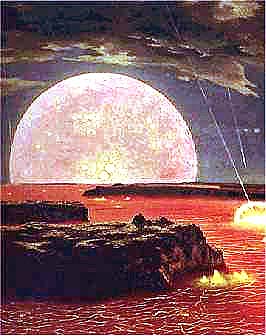 In principle therefore the Earth was a sphere of melted rock, churned by
convective movements between the hot inner layers, while the outer, surface
regions were in contact with the cold of surrounding space. The
dissipation of heat to space began the cooling of our planet. In the magma ocean
blocks began to appear, formed from high melting point minerals. These red hot,
but solid slabs were similar (although on a very different scale) to the thin edges of crust that we see forming
on the surface of flowing lava. The result is what sees in the
imaginative reconstruction to the right. Note that, in those times, the Moon, still burning, was
only 16,000 km from the Earth (compared to 384,000 km today), and for that
reason occupied a big part of the sky. Truly a nightmare landscape!
In principle therefore the Earth was a sphere of melted rock, churned by
convective movements between the hot inner layers, while the outer, surface
regions were in contact with the cold of surrounding space. The
dissipation of heat to space began the cooling of our planet. In the magma ocean
blocks began to appear, formed from high melting point minerals. These red hot,
but solid slabs were similar (although on a very different scale) to the thin edges of crust that we see forming
on the surface of flowing lava. The result is what sees in the
imaginative reconstruction to the right. Note that, in those times, the Moon, still burning, was
only 16,000 km from the Earth (compared to 384,000 km today), and for that
reason occupied a big part of the sky. Truly a nightmare landscape!
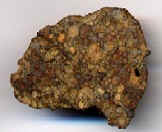 But those first fragments of crust must also have been very unstable, easily resorbed by the liquid mass of magma and sucked
into the depths. Only, with the further cooling of the planet, might those fragments
become numerous and large
enough to form a first, thin, solid cover -- that is to say, a true primitive crust.
This primordial crust might have developed as a warm expanse of rocks (some hundreds of degrees Celsius),
interrupted by numerous large breaks, from which enormous
quantities of magma continued to erupt. At this early point in the history of the Solar
System, meteoric bombardment was intense, and it would have continually opened new
holes in the crust, immediately filled by magma. The scars left by this
intense meteoric bombardment
have been almost totally erased on the Earth by subsequent reworking of the
crust. However, the resulting impact craters and lava flows are perfectly preserved on the Moon and on
many other bodies in the Solar System whose geological evolution ended long
ago.
But those first fragments of crust must also have been very unstable, easily resorbed by the liquid mass of magma and sucked
into the depths. Only, with the further cooling of the planet, might those fragments
become numerous and large
enough to form a first, thin, solid cover -- that is to say, a true primitive crust.
This primordial crust might have developed as a warm expanse of rocks (some hundreds of degrees Celsius),
interrupted by numerous large breaks, from which enormous
quantities of magma continued to erupt. At this early point in the history of the Solar
System, meteoric bombardment was intense, and it would have continually opened new
holes in the crust, immediately filled by magma. The scars left by this
intense meteoric bombardment
have been almost totally erased on the Earth by subsequent reworking of the
crust. However, the resulting impact craters and lava flows are perfectly preserved on the Moon and on
many other bodies in the Solar System whose geological evolution ended long
ago.
A very few terrestrial locations (primarily Isua in Greenland
and Western Australia) preserve rocks dating from near the end of the Hadean.
These give mixed signals about the state of the crust at that time. Lead
isotope ratios suggest that crust subduction was occurring, implying that Earth
had a recognizable crust doing recognizable plate tectonics.
Frei et al. (2004). However,
the same authors suggest that, while a " protocrust" had differentiated from the
underlying mantle as early as 4300 Mya, its composition was basaltic (as
apposed to today's granitic crust) and "conceivably
without any present-day analogues."
protocrust" had differentiated from the
underlying mantle as early as 4300 Mya, its composition was basaltic (as
apposed to today's granitic crust) and "conceivably
without any present-day analogues."
From a petrographic point of view, the primitive crust was similar to basalt, a dark volcanic rock, with less than 53 % SiO2 by weight. This basalt was formed from the material of the mantle, but had a rather different composition. Perhaps it was similar to the primordial crust of the Moon, much of which still remains in the lunar highlands. The lunar crust is largely anorthosite, a feldspar rich in aluminum, but otherwise chemically similar to the lunar basalts. Bhandari (2002).
According to one school of thought, the composition of the crust began to change by a sort of distillation. Disrupted by highly energetic convective movements, the thin lithospheric covering would have been fragmented into numerous small plates in continuous mutual movement, separated and deformed by bands of intense vulcanism. During this continuous remelting of the "protocrust," heavier rock gradually sank deeper into the mantle, leaving behind a lighter magma richer in silicates. Thus, around the basalts appeared andesites: fine granular volcanic rocks, whose name derives from the Andes, where several volcanoes are known to form rocks of this type. Gradually, a granitic crust emerged.
But there are problems. In addition to mixed signals from
isotope analysis of Isuan rocks, workers have also been puzzled by questions
relating to the "Late Heavy Bombardment" (LHB). The theory is that Earth
was hit by a large number of relatively massive bodies late in the Hadean, over
a relatively short period (50 My or so). The evidence for the LHB is quite
strong. It comes mostly from lunar astronomy (big craters formed
significantly later than the lunar maria) and the lunar rocks recovered from
space exploration. The implication, for many geologists, is that the post-Hadean granitic crust
was not the product of gradual distillation, but of catastrophic
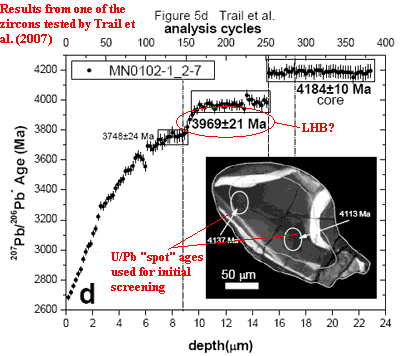 reworking after
the protocrust was destroyed by the LHB. Koeberl
(2003) (reviewing earlier work).
reworking after
the protocrust was destroyed by the LHB. Koeberl
(2003) (reviewing earlier work).
Trail et al. (2007) have recently performed some particularly elegant studies on zircons older than the LHB from exposures near the Jack Hills in Western Australia. By way of background, note that zircon crystals are frequently used for dating because they are completely inert up to temperatures of about 900° C. and because the crystals frequently trap heavy metals (U, Th, Lu, etc.), but exclude lead (Pb). Thus, any lead in the crystal must come from radioactive decay.
One potential problem with the method is that zircon crystals can grow by adding material to the outside when exposed to temperatures of several hundred °C -- well below the point at which they begin to "leak" lead. Trail turned this problem to advantage. Using an ion microprobe, Trail measured U/Pb ratios for two different isotopes of uranium, which have different half-lives and which produce different lead isotopes on decay. The microprobe allowed these workers to perform hundreds of measurements at different depths in the crystal -- essentially peeling the zircon back, about 100 nm at a time, to reconstruct its growth history.
Zircons older than 3900 My are incredibly rare, but, after sorting through thousands, Trail et al. found four which (a) passed the internal tests of "concordance" between the two isotope pairs and (b) were over 4000 My old at the deepest levels. The four had significantly different maximum ages and showed somewhat different geological histories, both before and after the LHB. However, all four turned out to have a substantial secondary growth layer at 3950 ± 30 My, just at the beginning of the LHB as estimated from lunar sources. Evidently, something heated up at about this time, on at least a regional basis; but not by so much that these zircons leaked or melted. This is consistent with the LHB, and also with some specific new ideas about the LHB which are discussed below.
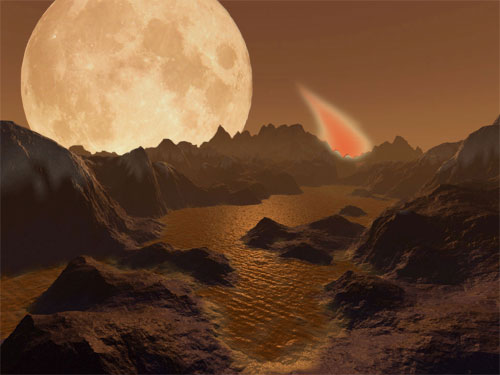 As a result of the high temperatures at the center of the Earth, and due to volcanic activity,
the crust emitted halogen gasses, ammonia, hydrogen, carbon dioxide, methane,
water vapor, and other gasses. In the following 100 million years, these gasses
accumulated to form the primordial
atmosphere. This atmosphere was quite similar to the atmosphere of Titan,
one of the larger moons of Saturn. The primordial atmosphere is believed to have reached a
pressure of 250 atmospheres and would have been extremely toxic to life as we
now know it.
As a result of the high temperatures at the center of the Earth, and due to volcanic activity,
the crust emitted halogen gasses, ammonia, hydrogen, carbon dioxide, methane,
water vapor, and other gasses. In the following 100 million years, these gasses
accumulated to form the primordial
atmosphere. This atmosphere was quite similar to the atmosphere of Titan,
one of the larger moons of Saturn. The primordial atmosphere is believed to have reached a
pressure of 250 atmospheres and would have been extremely toxic to life as we
now know it.
But, little by little our planet assumed a more familiar look, with a dense gaseous cloud zone we could call an atmosphere, a liquid zone with oceans, lakes and rivers, or hydrosphere, and a solid zone, or lithosphere with the first outlines of what would one day become continents. The process of cooling and consolidation of the Earth's surface was accompanied, as still occurs in volcanoes, by strong outgassing of new atmosphere, formed essentially from methane (CH4), hydrogen (H2), nitrogen (N2) and water vapor, with smaller amounts of noble gases and carbon dioxide. Most of the hydrogen, the lightest component, escaped into space, as also happens today. The other gases and vapors accumulated, including water vapor. The water did not condense at this point, early in the Hadean, because the temperatures of the crust was still very high.
Image: This started as a pre-Huygens Mission NASA rendering of Titan by Steven Hobbs. Then we started adding things ... . Don Dixon also has interesting recreations of the Hadean.
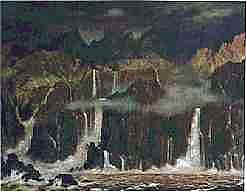 At the same time, another important series of events began to unfold that led
to the formation of sedimentary rocks through the processes of erosion, drift, and accumulation. These processes began to occur as soon as
the surface cooled enough to allow the water cycle to establish itself In fact, the primitive Earth long remained covered in
darkness, wrapped in dense burning clouds into which continuously poured
water vapor from volcanic emissions. When temperatures finally cooled
sufficiently, the clouds began to melt into rain, and the primordial atmosphere
produced storms of unimaginable proportions, under which the Earth groaned and
flowed. At first, falling on incandescent rock, the rain evaporated, but
the evaporation gradually cooled the crust until the water could accumulate in
the depressed regions of the Earth's surface, forming the first oceans. On
the primordial continents, the first river networks were created, and they
transported detritus torn from elevated regions and then deposited on the bottom
of the primordial seas. The metamorphism and remelting of the products of
the erosion ultimately produced magmas and lava increasingly rich in silicates,
and therefore of different composition from the mantle and the primitive crust.
At the same time, another important series of events began to unfold that led
to the formation of sedimentary rocks through the processes of erosion, drift, and accumulation. These processes began to occur as soon as
the surface cooled enough to allow the water cycle to establish itself In fact, the primitive Earth long remained covered in
darkness, wrapped in dense burning clouds into which continuously poured
water vapor from volcanic emissions. When temperatures finally cooled
sufficiently, the clouds began to melt into rain, and the primordial atmosphere
produced storms of unimaginable proportions, under which the Earth groaned and
flowed. At first, falling on incandescent rock, the rain evaporated, but
the evaporation gradually cooled the crust until the water could accumulate in
the depressed regions of the Earth's surface, forming the first oceans. On
the primordial continents, the first river networks were created, and they
transported detritus torn from elevated regions and then deposited on the bottom
of the primordial seas. The metamorphism and remelting of the products of
the erosion ultimately produced magmas and lava increasingly rich in silicates,
and therefore of different composition from the mantle and the primitive crust.
The timing of these various events continues to be a problem. We have already mentioned some evidence for the existence of a protocrust and some form of plate tectonics at a very early date. Relatively recent work has only strengthened the case for oceans before 4000 Mya. Wilde et al. (2001). In addition, it appears that things cooled off fairly quickly after the Earth and moon were formed at around 4500 Mya. Wood & Halliday (2005). Accordingly, ocean and crust had a chance to stabilize. Can this be reconciled with the "cataclysm" of the LHB, or did the crust and oceans have to start all over again?
At the moment, the answer seems to be "no." That is, the LHB was a less-than-cataclysmic cataclysm. As Ryder (2003) pointed out, our best information on the LHB comes from the moon. Since much of the moon's original crust remains, why would we think that the crust of the Earth was destroyed? Some workers even argue that life evolved before the LHB and survived to tell the tale. Russell & Arndt (2005). If we understand the argument, Russell & Arndt are asserting that, precisely because the oceanic crust was poorly differentiated from mantle basalt, it was thick, rigid, and non-conductive, providing both physical stability and thermal insulation against the effects of impacts. Continental crust, by contrast, was ultramafic (very dense), thin, and turned over rapidly. This promoted hydration of the upper mantle and also drove the sort of distillation process which created the lighter crust of post-Hadean time. The LHB, if not too extensive, would only have moved this evolution along at a faster rate. ATW
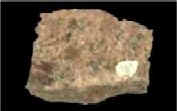 From all these processes, such as the remelting of part of the basaltic
primitive crust, accompanied by metamorphism and melting of large quantities of
sediments, there gradually formed magmas similar in composition to granites, and
therefore able to "float" on basalt.
From all these processes, such as the remelting of part of the basaltic
primitive crust, accompanied by metamorphism and melting of large quantities of
sediments, there gradually formed magmas similar in composition to granites, and
therefore able to "float" on basalt.
Fragment by fragment, formed in the beginning from island chains similar to modern-day volcanic island arcs, the continental crust was born, and so the external land cover of the planet. This new type of crust had a unique feature of fundamental importance: its low density kept it riding on the surface. Thus it was able to undergo intense transformations, such as mechanical deformation (tectonics) or metamorphism, but remain always in proximity to the surface. While the primitive basaltic crust has probably been permanently lost, geologists have found some traces of those first outlines of continental crust. In 1983, in western Australia, were found the most ancient rocks known to date. These rocks are dated to about 4.2 billion years. Remarkably, these are sandstones. This means that they were derived from the erosion of other rocks, still more ancient! FMB03xxxx
Introduction to the Hadean - UCMP; Hadean - Wikipedia; ; The Earth as a Planet - good page on the early Earth, includes material relevant to both the Chaotian and the Hadean Earth in the Beginning (National Geographic - short essay); Geol 02C, Historical Geology, The Hadean Eon (study notes); Hadean Eon - essay web. MAK110907
| Page Back | Unit Home | Page Top | Page Next |
